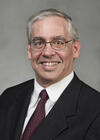In The News: Department of Political Science

For generations, redlining was used to designate neighborhoods—typically in urban areas with high concentrations of minority residents—as places banks should avoid offering home mortgages. The term originates from Federal Housing Administration maps developed in the 1930s where “red” labeled high-risk lending zones. To be “redlined” meant that households were structurally denied home loans and lost the opportunity to build wealth.

For generations, redlining was used to designate neighborhoods—typically in urban areas with high concentrations of minority residents—as places banks should avoid offering home mortgages. The term originates from Federal Housing Administration maps developed in the 1930s where “red” labeled high-risk lending zones. To be “redlined” meant that households were structurally denied home loans and lost the opportunity to build wealth.

In this special edition of the podcast, Bill Finan—director of the Brookings Institution Press—talks with two of the authors of a new Brookings press book that explores America’s current political division from demographic and geographic perspectives. David Damore, Robert Lang, and Karen Danielsen, all professors at the University of Nevada Las Vegas, are co-authors of Blue Metros, Red States: The Shifting Urban-Rural Divide in America’s Swing States. Damore and Lang join Finan for this episode in which they address some of the factors that tend to make large metropolitan areas lean Democratic while existing in a sea of rural areas that are largely Republican. And, how do states like Pennsylvania, Georgia, and Texas—with both large urban areas and widespread rural areas—express this red-blue divide between rural and metropolitan areas? Listen also to find out which two counties in America could indicate which way the election is going on November 3.

In this special edition of the podcast, Bill Finan—director of the Brookings Institution Press—talks with two of the authors of a new Brookings press book that explores America’s current political division from demographic and geographic perspectives. David Damore, Robert Lang, and Karen Danielsen, all professors at the University of Nevada Las Vegas, are co-authors of Blue Metros, Red States: The Shifting Urban-Rural Divide in America’s Swing States. Damore and Lang join Finan for this episode in which they address some of the factors that tend to make large metropolitan areas lean Democratic while existing in a sea of rural areas that are largely Republican. And, how do states like Pennsylvania, Georgia, and Texas—with both large urban areas and widespread rural areas—express this red-blue divide between rural and metropolitan areas? Listen also to find out which two counties in America could indicate which way the election is going on November 3.
Of all the many reasons to vote this year, for some people one seat is all they need. That seat happens to be on the United States Supreme Court.

The passing of Supreme Court Justice Ruth Bader Ginsburg made me reflect on her quote, “Women belong in all places where decisions are being made. It shouldn’t be that women are the exception.”

Candidates for the upcoming election are vying for every vote available, and there may be no voter group more coveted than the Latinos and Hispanics.
Although some still hold a positive outlook for the trajectory of U.S.-China relations, many more now see different versions of a Cold War 2.0 as the basis for the interactions of the two hegemons. As more countries around the world start to flock to either one of the two camps, Taiwan, sandwiched in this rising power rivalry, has also been thinking about its next step. Some have advocated Taiwan follow a hedging policy or maintaining an equal distance between both countries to maximize its flexibility should geopolitics change dramatically. Such a viewpoint is wrong. As U.S.-China rivalry intensifies, it is in Taiwan’s best interests to stand closely with the United States and its allies as a global partner. It is also essential for U.S. policymakers to understand the Taiwanese debate dynamics on U.S. and China policy because U.S. policy vis-à-vis Taiwan certainly shape the broader agenda.
If any state seems ripe for a robust third party, it might be Utah. It’s a heavily Republican state, but one that still isn’t sold on Donald Trump. Investment banker Evan McMullin, running as a conservative independent, took 21 percent of Utah’s presidential vote in 2016, only six percentage points less than Democrat Hillary Clinton.

The Declaration of Independence does not prescribe a particular form of government for the securing of our inalienable rights, but it leaves no doubt that government is necessary. The people may be the best judge of how the mask fits, but these days, can we do without masks?

Redlining was a government-sanctioned discriminatory policy that designated most urban minority-majority neighborhoods as places banks should not offer home mortgages. The term originates in color maps developed in the late 1930s by Homer Hoyt, an economist with the Federal Housing Administration, to direct mortgage loans made by the Home Owner’s Loan Corp. Redlining refers to the map’s color-coded neighborhood types: red zones indicated high-risk investments; yellow zones medium risk; and green zones low risk.

Redlining was a government-sanctioned discriminatory policy that designated most urban minority-majority neighborhoods as places banks should not offer home mortgages. The term originates in color maps developed in the late 1930s by Homer Hoyt, an economist with the Federal Housing Administration, to direct mortgage loans made by the Home Owner’s Loan Corp. Redlining refers to the map’s color-coded neighborhood types: red zones indicated high-risk investments; yellow zones medium risk; and green zones low risk.


